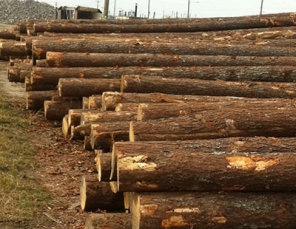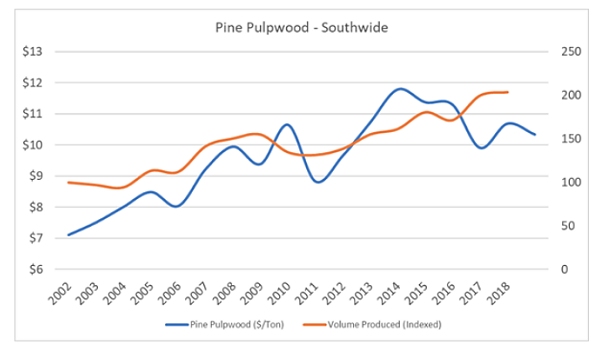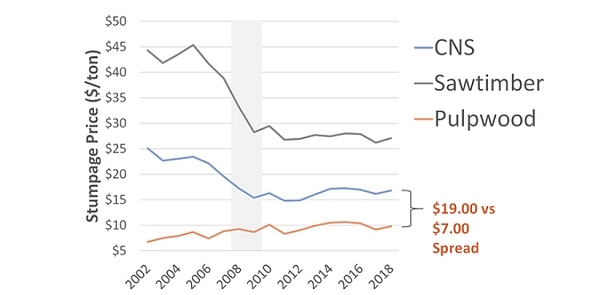
Pine Pulpwood: Driving the Southern Timber Price ReboundBy Joe Clark, Stumpage Forester at Forest2Market  On a Southwide (U.S.) basis, pine pulpwood prices are up 47% while pine sawtimber prices are down 35% since 2002.
On a Southwide (U.S.) basis, pine pulpwood prices are up 47% while pine sawtimber prices are down 35% since 2002.
Nov. 18, 2019 - We are more than a decade removed from the depths of the Great Recession and despite 10 years of solid growth, timber prices across the South have still not returned to the pre-crash levels of the early 2000s. The primary reason for this is rooted in a basic supply/demand relationship, as the trees are simply growing faster than the market for them. While many mills were forced to adapt and improve efficiencies in the immediate aftermath of the Great Recession, many landowners simply pulled their timber off the market and waited it out in hopes that prices would trend higher in the future. This combination has caused the total volume of logs on the stump throughout the US South to rise unimpeded over the last decade. This oversupply combined with improved mill efficiencies is keeping log prices low, even as demand for lumber and sawmill production slowly increases. The housing market remains a mystery I have yet to crack, however log data from the South points to some promising trends for southern timber owners. Defining the Price 'Rebound'Solid wood manufacturing and demand for sawtimber has always informed the way we tend to think about the overall price driving timberland ownership and investment. While pulpwood has traditionally been viewed as a “come-along” byproduct of a sawtimber harvest, the market for pine pulpwood across the South has surged over the last decade. New demand driven by evolving markets and changing end-use products has made pine pulpwood the lynchpin that is now responsible for the overall price increase in weighted southern timber prices over the last 10 years. As demand for pulpwood has increased, the average price has increased in tandem with production volumes. There have been some periods of volatility since 2002 driven in part by the Great Recession and weather conditions, but pine pulpwood prices have continued to trend upward. On a Southwide basis, pine pulpwood prices are up 47% while pine sawtimber prices are down 35% since 2002. 
However, the recovery of the pine pulpwood market has not been consistent across the South. As the heat map below illustrates, there are pockets throughout the region with varying levels of pulpwood demand, which has affected pulpwood prices. In general, the coastal areas have been the strongest markets for the pine pulpwood revival. For example, a large swath of area from southeastern Georgia into northeastern Florida has seen pine pulpwood prices jump nearly 150% since the onset of the Great Recession. 
While this trend doesn't include the big sawtimber rally than many landowners have awaited, it nevertheless represents a new source of long-term demand for a southern a timber product that is driving the current rebound. New Demand, New MarketsDuring early years of economic recovery, pulpwood really propped up the weighted average timber price throughout the South, and this dynamic continues as we see the market grow stronger and the gap between pine pulpwood, chip-n-saw and sawtimber has narrowed. 
Notice that the trend for CNS has largely followed that of pulpwood since 2014. In especially hot markets, strong demand for pulpwood is squeezing the CNS market as some pulp mills are even choosing to reach up into the CNS category for fiber. What segments are driving this demand? The Amazon Effect: ContainerboardContainerboard is a specific type of paperboard that is manufactured for use in the production of both linerboard (facing) and corrugating medium (fluting), the two wood fiber components that make up cardboard boxes. According to the American Forest & Paper Association, more than 95% of all products in the US are shipped in cardboard boxes, which are made from high-strength softwood fiber. This product is very well-positioned in the growing e-commerce market, as online orders arrive in high-grade cardboard boxes to prevent damage during shipping. Since most containerboard is made from softwood fiber, the e-commerce phenomenon is sustaining demand for softwood residual chips and pulpwood as manufacturers of containerboard products prefer softwood fiber because of its strength characteristics. Over the last several years, this segment has increased global production by nearly 2% annually and demand for containerboard is increasing at an annual rate between 2-4%. Demand trends look favorable for the future as well; e-commerce sales are expected to increase from 10.2% of all retail sales to 17.5% in 2021. Population Boom: Fluff PulpHigh-quality fluff pulp is an absorbent material made from pine pulpwood fiber that is used globally in a variety of applications such as feminine hygiene products, baby diapers and adult incontinence products. While this is a relatively small market at 6 million tons currently, worldwide demand is increasing at 4% annually. This is a clear example of a situation where a change in customer preference has not changed the total demand for a wood raw material, but rather has shifted the demand from one product (hardwood pulp) to another (southern conifer pulp). The complete story can be found on Forest2Market's website: www.forest2market.com/blog/pine-pulpwood-driving-the-southern-timber-price-rebound. About Forest2Market, Inc.Forest2Market provides pricing data, supply chain expertise and strategic consulting services to participants in the global wood and fiber supply chain. The Forest2Market's unique databases contain more than 400 million rows of transaction data; they are the foundation for all analytics available in the firm's business intelligence platform, SilvaStat360, as well as client resource studies and consulting engagements. To learn more, visit www.forest2market.com. SOURCE: Forest2Market |